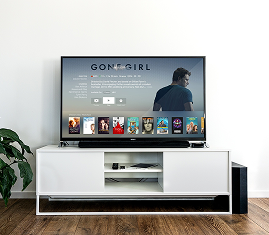You love listening to music or watching movies, but have you ever wondered how you can enhance your audio experience? Well, look no further as we delve into the world of surround sound systems. In this article, we will explore the benefits of moving beyond traditional two-channel audio and embracing the immersive world of surround sound. Whether you’re a music enthusiast or a movie buff, surround sound systems offer a whole new level of audio quality and immersion that will leave you completely captivated. So, grab your favorite snacks, sit back, and get ready to dive into the exciting world of surround sound.
Understanding Two-Channel Audio
Definition of Two-Channel Audio
Two-channel audio refers to a standard audio system that uses two channels of audio recording and playback. It is commonly known as stereo sound, where sound is divided into two discrete channels, typically labeled as left and right. The two-channel audio system provides a basic level of audio reproduction, creating a sense of space and depth by utilizing two separate speakers. It is the traditional format used in most music recordings, movies, and television shows.
Common Applications of Two-Channel Audio
Two-channel audio is widely used in various applications, including home entertainment systems, music production, broadcasting, and live performances. It is the foundation of stereo sound reproduction and provides a simple and accessible way to enjoy audio content. Two-channel audio is commonly used in stereo speakers, headphones, and car audio systems, providing listeners with an immersive audio experience that captures the nuances and details of the original recording.
Limitations of Two-Channel Audio
While two-channel audio is a popular and widely adopted format, it has its limitations. One of the main limitations is the lack of spatial accuracy and immersion. With only two channels, it becomes challenging to reproduce sound accurately from multiple directions. Two-channel audio also struggles to convey a sense of height, making it difficult to create an immersive audio experience. Additionally, two-channel audio may not fully capture the complexity and dynamics of certain audio recordings, limiting the overall fidelity and realism of the sound reproduction.
Introduction to Surround Sound Systems
What is Surround Sound?
Surround sound is a technology that aims to create a more immersive and realistic audio experience by placing speakers around the listener to mimic the way sound occurs in the real world. Unlike the two-channel audio, which only has two speakers, surround sound systems utilize multiple channels of audio to reproduce sound from various directions, including front, rear, and sides. This multi-channel setup allows for a more accurate representation of sound and creates a three-dimensional audio environment.
Benefits of Surround Sound Systems
One of the primary benefits of surround sound systems is the enhanced immersion it provides. By distributing sound through multiple speakers strategically placed in the listening area, surround sound can create a sense of depth, directionality, and realism. This added dimensionality significantly enhances the audio experience, making movies, music, and gaming more engaging and captivating. Surround sound systems also allow for better localization of sounds, enabling viewers to accurately perceive where the sound is coming from, further enhancing the overall audio experience.
How Surround Sound Enhances Audio Experience
Surround sound systems go beyond the limitations of two-channel audio by adding additional speakers to create a more immersive audio environment. By enveloping the listener with sound from multiple directions, surround sound systems can reproduce audio with a greater sense of space and realism. This enhanced audio experience can transport listeners into the heart of a movie scene, allowing them to feel as if they are right there, or immerse them in a virtual gaming world, where they can hear every detail with accuracy. Surround sound truly elevates audio to a whole new level.
Different Types of Surround Sound Systems
5.1 Surround Sound
5.1 surround sound is one of the most common and widely adopted surround sound systems. The “5” refers to the five main speakers, which include a center speaker, left and right front speakers, and left and right rear speakers. The “1” denotes the presence of a subwoofer, which is responsible for reproducing low-frequency sounds, such as deep booms and explosions. This configuration provides a balanced and immersive sound experience, creating a realistic audio environment.
7.1 Surround Sound
As the name suggests, 7.1 surround sound takes the 5.1 system and adds two additional rear speakers, creating a more expansive soundstage. The extra rear speakers allow for a more precise localization of sound, enhancing the overall immersion. This configuration is particularly popular in larger home theater setups or dedicated audio listening rooms, where the additional speakers can be accommodated.
9.2 Surround Sound
9.2 surround sound is the next level of audio immersion, taking the 7.1 setup and adding two more channel speakers and a second subwoofer. The additional channel speakers further enhance the surround sound experience, creating a more precise and lifelike audio reproduction. The second subwoofer adds more depth and impact to the low-frequency sounds, resulting in a more powerful and immersive audio experience.
Dolby Atmos
Dolby Atmos is the latest and most advanced surround sound technology. It takes the concept of surround sound to a whole new level by introducing height speakers and object-based audio. In a Dolby Atmos setup, speakers are not confined to the floor level but can also be placed above the listener to create a three-dimensional sound experience. This allows for a more accurate localization of sound and a more realistic representation of how sound occurs in the real world. Dolby Atmos is truly revolutionizing the way we experience audio, providing a truly immersive and captivating audio experience.
Components of a Surround Sound System
Sound Channels
In a surround sound system, the sound channels refer to the individual audio signals that are sent to the speakers. The number of sound channels corresponds to the number of speakers in the system. The most common configurations include 5.1, 7.1, and 9.2, which determine the number and placement of speakers in the setup. Each channel carries a unique audio signal, and collectively, they create a sense of space and immersion.
Loud Speakers
Loudspeakers are an essential component of a surround sound system. They are responsible for converting electrical signals into sound waves that are audible to the listener. Different speakers serve different roles in the system, such as front speakers for delivering dialogue and main audio, rear speakers for creating a sense of atmosphere, and subwoofers for reproducing low-frequency sounds. Choosing high-quality loudspeakers that are suitable for the specific surround sound system is crucial for achieving optimal audio performance.
Subwoofers
Subwoofers are specialized loudspeakers designed to reproduce low-frequency sounds, commonly referred to as bass. They play a critical role in a surround sound system as they provide depth and impact to explosions, music, and other low-frequency effects. Subwoofers can be placed anywhere in the listening area to create an immersive bass experience. Depending on the surround sound system configuration, there may be one or multiple subwoofers in the setup.
Audio/Video Receiver (AVR)
The audio/video receiver is the central hub of a surround sound system. It acts as the control center, responsible for processing and amplifying the audio signals from various sources. The AVR connects to the input devices, such as a Blu-ray player, gaming console, or television, and routes the audio signals to the appropriate speakers. It also provides various audio processing options and settings to fine-tune the sound according to the listener’s preferences.
Dolby Digital Encoding
Dolby Digital encoding is a standard audio compression format used in surround sound systems. It allows for the efficient storage and transmission of audio signals while maintaining high audio fidelity. Dolby Digital encoding ensures that the audio sent from the source device to the AVR is decoded and reproduced accurately by the individual speakers. This encoding method is widely supported by various audio formats and devices, ensuring compatibility and consistent audio performance.
Setting Up a Surround Sound System
Choosing the Right Equipment
When setting up a surround sound system, it is crucial to choose the right equipment that matches your specific needs and preferences. Consider factors such as the size of your room, the level of audio fidelity desired, and the available budget. Research different brands, models, and speaker types to find the best combination that suits your requirements. It is also essential to consider the compatibility of the equipment, ensuring that the components work together seamlessly.
Positioning of Speakers
Correct placement of the speakers is critical to achieving optimal sound performance in a surround sound system. Each speaker has a specific role and positioning it in the right location ensures a cohesive and immersive audio experience. Front speakers should be placed equidistant from the primary listening position and ideally at ear level. Rear speakers should be positioned behind the listener, while the subwoofer can be placed anywhere in the room with an emphasis on finding the ideal spot for balanced bass reproduction.
Adjusting the Sound
Once the speakers are set up, it is essential to adjust the sound settings to achieve the desired audio experience. The audio/video receiver provides various adjustment options, including speaker distance, volume levels, equalization, and sound modes. Experiment with different settings to find the sweet spot that balances the audio across all the channels. Fine-tuning the sound ensures accuracy, balance, and an immersive audio experience.
Common Setup Mistakes to Avoid
When setting up a surround sound system, it is important to avoid common mistakes that may compromise the audio performance. One such mistake is improper speaker placement, such as positioning the speakers too close together or too far apart. Another mistake is neglecting acoustic considerations, such as room layout and furniture placement, which can impact the sound quality. Furthermore, overlooking calibration and sound adjustment settings can prevent the system from reaching its full potential. Taking the time to avoid these mistakes will result in a more satisfying surround sound experience.
Auditing and Fine-tuning a Surround Sound System
Importance of Auditing
Auditing a surround sound system is a crucial step in ensuring optimal audio performance. It involves carefully listening to the audio playback and identifying any issues, such as incorrect localization, imbalances, or distortion. By conducting an audit, you can pinpoint areas that may need adjustment or fine-tuning, allowing you to make the necessary changes to achieve the best possible audio experience.
Auditing Techniques
There are several techniques you can employ when auditing a surround sound system. The first is actively listening to various audio sources, such as movies, music, and games, and paying attention to the quality, clarity, and balance of the sound. Another technique is conducting sound tests, which involve playing specific audio signals to assess the performance of individual speakers and channels. You can also use calibration tools, such as sound level meters or microphone systems, to measure and analyze the audio output accurately.
Fine-tuning for Optimum Performance
After auditing the surround sound system, fine-tuning can be done to optimize its performance. This includes adjusting the speaker levels, equalization settings, and crossover frequencies. Fine-tuning also involves addressing any acoustic issues in the room by strategically placing acoustic panels or diffusers to enhance sound absorption and diffusion. Taking the time to fine-tune the system will result in a more accurate, balanced, and immersive audio experience.
Troubleshooting Common Problems
When it comes to surround sound systems, there may be occasional issues or problems that arise. These can include sound dropouts, incorrect channel assignments, static noise, or distorted sound. Troubleshooting these issues may involve checking cable connections, recalibrating the system, updating firmware, or resetting the audio/video receiver. By following troubleshooting steps provided by the manufacturer or seeking technical support, you can resolve common problems and ensure continued optimal performance of your surround sound system.
The Role of Acoustics in Surround Sound
Understanding Room Acoustics
Room acoustics refers to the way sound behaves within a specific space. It is influenced by factors such as room size, shape, materials, furniture, and other objects within the room. Room acoustics play a critical role in the overall sound quality and performance of a surround sound system. Understanding how sound interacts with the room is essential for creating an optimized listening environment that maximizes the potential of the surround sound system.
How Room Acoustics Affect Sound
Room acoustics can have a significant impact on the sound reproduction of a surround sound system. Various factors, such as room dimensions, parallel walls, and reflective surfaces, can introduce acoustic issues, including standing waves, echoes, and excessive reverberation. These issues can result in uneven frequency response, poor sound localization, and reduced clarity. Properly managing room acoustics through sound absorption, diffusion, and reflection can help minimize these issues and improve the overall audio experience.
Improving Room Acoustics
Improving the room acoustics can greatly enhance the performance of a surround sound system. Several measures can be taken to optimize the listening environment. One approach is to strategically place sound-absorbing materials, such as acoustic panels or bass traps, to reduce excessive reflections and control low-frequency resonances. Diffusion panels can be utilized to scatter sound waves, improving sound dispersion and creating a more spacious soundstage. Additionally, arranging furniture and speaker placement to minimize the impact of parallel walls can help mitigate standing wave issues.
Acoustic Treatment
Acoustic treatment involves implementing various techniques and materials to improve the sound quality and performance within a room. This can include the use of acoustic panels, bass traps, diffusers, and other specialized products designed to absorb, scatter, or diffuse sound waves. Acoustic treatment aims to achieve a more balanced frequency response, enhance sound localization, minimize echoes and resonances, and create a more accurate and immersive surround sound experience.
Surround Sound for Home Theaters
Benefits of Surround Sound in Home Theaters
Surround sound greatly enhances the home theater experience, providing a more immersive and realistic audio environment. It complements the high-definition video by adding a layer of depth, dimensionality, and spatial accuracy to the sound. This creates a truly engaging cinematic experience, where viewers feel like they are part of the action. Surround sound in home theaters allows for a more accurate representation of the director’s vision, ensuring that every sound effect, dialogue, and musical score is rendered with utmost clarity and impact.
Choosing a System for Your Home Theater
When selecting a surround sound system for your home theater, there are several factors to consider. These include the size and layout of the room, the types of content you will be watching, and your personal preferences for audio fidelity. It is important to choose a system that can accommodate your specific needs and deliver the level of audio performance you desire. Research different brands and models, read reviews, and consult with professionals to make an informed decision.
Setting Up Home Theater Surround Sound
Setting up a surround sound system in a home theater requires careful consideration of various factors. This includes speaker placement, cable management, room acoustics, and proper calibration. Each speaker should be placed in the optimal location to ensure accurate and immersive sound reproduction. Cable runs should be neat and organized to minimize signal loss and interference. The room acoustics can be enhanced through acoustic treatment to improve sound quality. Finally, calibration of the system ensures that the audio is balanced and accurate throughout the listening area.
Maintaining Your Home Theater System
Regular maintenance of your home theater surround sound system is crucial to ensure its continued optimal performance and longevity. This includes keeping the components clean and dust-free, checking and tightening any connections, and updating firmware or software as needed. It is also important to periodically audit and fine-tune the system to address any changes in the room acoustics or equipment performance. By properly maintaining your home theater system, you can enjoy the immersive surround sound experience for years to come.
Surround Sound in Gaming
Benefits of Surround Sound in Gaming
Surround sound greatly enhances the gaming experience by providing a more immersive and realistic audio environment. It allows gamers to accurately locate and identify in-game sounds, enhancing spatial awareness and immersion. With surround sound, gamers can hear approaching enemies, explosions, and environmental cues with precision, giving them a competitive edge. Surround sound in gaming creates a more captivating and engaging experience, drawing players deeper into the virtual world.
Gaming-specific Surround Sound Systems
There are gaming-specific surround sound systems available that are designed to cater specifically to the needs of gamers. These systems often feature specialized gaming modes, such as sound profiles optimized for specific game genres or virtual surround sound technologies. Gaming headsets with built-in surround sound capabilities are also popular among gamers, providing an immersive audio experience directly to the ears. These gaming-specific surround sound systems offer enhanced audio performance and customization options tailored to the gaming experience.
Setting Up a Gaming-focused Surround Sound System
When setting up a gaming-focused surround sound system, there are a few considerations to keep in mind. First, choose a system or headset that is compatible with your gaming platform, be it a console, PC, or mobile device. Consider the specific gaming genres you most enjoy and select a system that can deliver the audio fidelity and immersion required for those games. It is also important to optimize the speaker or headset placement for accurate sound localization. Fine-tune the system’s settings to achieve the desired balance and audio performance specific to gaming.
Future of Surround Sound Technology
Emerging Trends
The future of surround sound technology is an exciting realm that continues to push the boundaries of audio reproduction. One emerging trend is the use of object-based audio, which allows for precise positioning and movement of sound sources within a three-dimensional space. This technology enables a more immersive audio experience and greater flexibility in audio production. Another trend is the integration of artificial intelligence (AI) and machine learning algorithms into surround sound systems, which can optimize audio playback based on the listener’s preferences and environmental conditions.
Surround Sound in Virtual Reality
Virtual reality (VR) is a fast-growing technology that immerses users in a simulated three-dimensional environment. Surround sound plays a crucial role in enhancing the realism and immersion of VR experiences. By accurately reproducing audio from multiple directions, VR surround sound systems can create a convincing audio environment, allowing users to feel as if they are truly present in the virtual world. The integration of surround sound with virtual reality opens up new possibilities for gaming, entertainment, and even educational applications.
Potential Disruptions in the Space
As technology advances, there is always the potential for disruptive innovations in the surround sound space. One such disruption could come from advancements in wireless audio transmission, eliminating the need for physical speaker connections and allowing for greater flexibility in speaker placement. Another potential disruption lies in the development of haptic feedback technologies, which can create vibrations or sensations in response to audio stimuli, further enhancing the overall sensory experience. The future of surround sound technology holds many possibilities, and it will be exciting to see how these disruptions shape the audio landscape.
In conclusion, surround sound systems offer a leap forward in audio reproduction, going beyond the limitations of two-channel audio. With the ability to create a truly immersive audio experience, they elevate the way we enjoy movies, music, and gaming. Whether it’s a home theater setup or a gaming-focused system, setting up and fine-tuning a surround sound system requires careful consideration of various factors, such as speaker placement, acoustics, and equipment selection. By understanding the components and principles behind surround sound, individuals can create a personalized and optimized audio environment that brings audio content to life in a whole new way. The future of surround sound technology holds tremendous potential for even more immersive and realistic audio experiences, shaping the way we engage with audio in the years to come.










